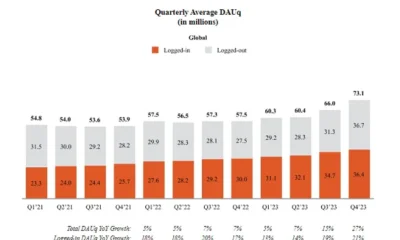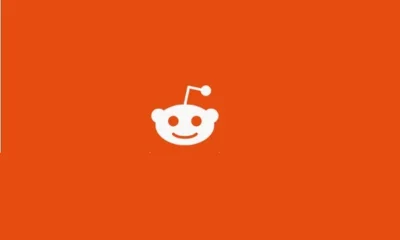SOCIAL
Clubhouse Looks to More Private Sharing as it Seeks to Regain its Growth Mojo

As it looks to redefine its identity, and recapture its growth momentum, Clubhouse has announced that it’s launching a new, more private approach to audio social meet-ups, with what it’s calling ‘Houses’, which are essentially more enclosed, invite-only spaces within the app.
As explained by Clubhouse:
“Think of Houses as private hallways just for your favorite people. You can drop in anytime, hop from room to room, catch up with friends, and meet their friends. Houses usually have regular meetup times, and everyone gets to nominate a few friends, so the House grows through people you trust. Or, you can keep it closed if you like – it’s fun either way!”
The process will essentially provide more control for users to curate the Clubhouse experience that they prefer, with the people that they want to hear from, as opposed to having to wade through the various rooms that may not be of relevance.
Because as with all live-streaming platforms, discovery is a challenge. When you give everyone a chance to broadcast, a lot of it will end up being crappy, because it takes skill and experience to create consistent, engaging content that will keep audiences entertained.
Most people simply can’t do this, and that, in turn, leads to a worse user experience, because you end up being confronted by an array of rubbish broadcasts every time you open the app, till eventually you just don’t bother looking anymore.
Clubhouse co-founder Paul Davison has essentially conceded that Clubhouse misstepped on this front:
“We [initially] tried to limit signups by requiring an existing member to invite you, but that perversely made people want to join more, and flooded the hallway with less relevant rooms. Noise causes churn, but somehow, millions made it through the madness, found their people, and form the core of our community today.”
Davison is trying to put a more positive spin on this, but again, we’ve seen the same with every live-streaming platform – the best streamers are great, and can drive huge value, but 90% of the broadcasts are not, and that disparity makes it very hard to build a truly engaging, scalable experience that will keep people coming back.
Which is what this new initiative is focused on. With Houses, you’ll be able to be more selective about the content you’re shown in the app, which will ideally limit those poor experiences.
“The best social experiences are not open to everyone. They are small and curated. This is what creates intimacy, trust and friendship.”
Though there will still be a level of discovery, even with this new approach.
House member lists will be public, while many rooms in the app will also remain publicly accessible. Users will also still be able to explore the hallways and discover new people, but the actual House rooms themselves will be private. So you’ll still be able to look around and seek out potentially valuable experiences. You just won’t be able to join them, unless you apply, or get in contact with the organizers some other way.
In some ways, it’s similar to the shift we’ve seen with Facebook, where engagement gradually shifted to Groups, and away from News Feeds. More recently, Instagram chief Adam Mosseri has said that engagement is now shifting into DMs, as opposed to the main feed, and in this sense, Clubhouse’s House approach could align with broader behaviors in other apps.
But I’m not sure it’s a growth lever, which is what Clubhouse really needs.
Ideally, Clubhouse would be able to curate the best experiences for each user, and maximize listenership for each broadcast – as opposed to closing them off and making it a more private experience.
That option might well boost engagement among existing users. But whether it will make it more inviting for others, I’m not so sure.
But Clubhouse needs to try something. According to reports, Clubhouse saw 3.8 million new installs globally between January 1st and May 31st this year, compared to 19 million installs during the same period in 2021 – an 80% year-over-year decline.
Maybe, then, Clubhouse’s potential as a broad usage tool is already too far gone, and it needs to seek out more specific niches to solidify its footing.
You can sign up for the Clubhouse ‘Houses’ beta test here.
SOCIAL
Snapchat Explores New Messaging Retention Feature: A Game-Changer or Risky Move?

In a recent announcement, Snapchat revealed a groundbreaking update that challenges its traditional design ethos. The platform is experimenting with an option that allows users to defy the 24-hour auto-delete rule, a feature synonymous with Snapchat’s ephemeral messaging model.
The proposed change aims to introduce a “Never delete” option in messaging retention settings, aligning Snapchat more closely with conventional messaging apps. While this move may blur Snapchat’s distinctive selling point, Snap appears convinced of its necessity.
According to Snap, the decision stems from user feedback and a commitment to innovation based on user needs. The company aims to provide greater flexibility and control over conversations, catering to the preferences of its community.
Currently undergoing trials in select markets, the new feature empowers users to adjust retention settings on a conversation-by-conversation basis. Flexibility remains paramount, with participants able to modify settings within chats and receive in-chat notifications to ensure transparency.
Snapchat underscores that the default auto-delete feature will persist, reinforcing its design philosophy centered on ephemerality. However, with the app gaining traction as a primary messaging platform, the option offers users a means to preserve longer chat histories.
The update marks a pivotal moment for Snapchat, renowned for its disappearing message premise, especially popular among younger demographics. Retaining this focus has been pivotal to Snapchat’s identity, but the shift suggests a broader strategy aimed at diversifying its user base.
This strategy may appeal particularly to older demographics, potentially extending Snapchat’s relevance as users age. By emulating features of conventional messaging platforms, Snapchat seeks to enhance its appeal and broaden its reach.
Yet, the introduction of message retention poses questions about Snapchat’s uniqueness. While addressing user demands, the risk of diluting Snapchat’s distinctiveness looms large.
As Snapchat ventures into uncharted territory, the outcome of this experiment remains uncertain. Will message retention propel Snapchat to new heights, or will it compromise the platform’s uniqueness?
Only time will tell.
SOCIAL
Catering to specific audience boosts your business, says accountant turned coach

While it is tempting to try to appeal to a broad audience, the founder of alcohol-free coaching service Just the Tonic, Sandra Parker, believes the best thing you can do for your business is focus on your niche. Here’s how she did just that.
When running a business, reaching out to as many clients as possible can be tempting. But it also risks making your marketing “too generic,” warns Sandra Parker, the founder of Just The Tonic Coaching.
“From the very start of my business, I knew exactly who I could help and who I couldn’t,” Parker told My Biggest Lessons.
Parker struggled with alcohol dependence as a young professional. Today, her business targets high-achieving individuals who face challenges similar to those she had early in her career.
“I understand their frustrations, I understand their fears, and I understand their coping mechanisms and the stories they’re telling themselves,” Parker said. “Because of that, I’m able to market very effectively, to speak in a language that they understand, and am able to reach them.”Â
“I believe that it’s really important that you know exactly who your customer or your client is, and you target them, and you resist the temptation to make your marketing too generic to try and reach everyone,” she explained.
“If you speak specifically to your target clients, you will reach them, and I believe that’s the way that you’re going to be more successful.
Watch the video for more of Sandra Parker’s biggest lessons.
SOCIAL
Instagram Tests Live-Stream Games to Enhance Engagement

Instagram’s testing out some new options to help spice up your live-streams in the app, with some live broadcasters now able to select a game that they can play with viewers in-stream.
As you can see in these example screens, posted by Ahmed Ghanem, some creators now have the option to play either “This or That”, a question and answer prompt that you can share with your viewers, or “Trivia”, to generate more engagement within your IG live-streams.
That could be a simple way to spark more conversation and interaction, which could then lead into further engagement opportunities from your live audience.
Meta’s been exploring more ways to make live-streaming a bigger consideration for IG creators, with a view to live-streams potentially catching on with more users.
That includes the gradual expansion of its “Stars” live-stream donation program, giving more creators in more regions a means to accept donations from live-stream viewers, while back in December, Instagram also added some new options to make it easier to go live using third-party tools via desktop PCs.
Live streaming has been a major shift in China, where shopping live-streams, in particular, have led to massive opportunities for streaming platforms. They haven’t caught on in the same way in Western regions, but as TikTok and YouTube look to push live-stream adoption, there is still a chance that they will become a much bigger element in future.
Which is why IG is also trying to stay in touch, and add more ways for its creators to engage via streams. Live-stream games is another element within this, which could make this a better community-building, and potentially sales-driving option.
We’ve asked Instagram for more information on this test, and we’ll update this post if/when we hear back.
-

 MARKETING7 days ago
MARKETING7 days agoRoundel Media Studio: What to Expect From Target’s New Self-Service Platform
-

 SEO6 days ago
SEO6 days agoGoogle Limits News Links In California Over Proposed ‘Link Tax’ Law
-
SEARCHENGINES6 days ago
Daily Search Forum Recap: April 12, 2024
-

 SEO5 days ago
SEO5 days ago10 Paid Search & PPC Planning Best Practices
-

 SEARCHENGINES5 days ago
SEARCHENGINES5 days agoGoogle Core Update Volatility, Helpful Content Update Gone, Dangerous Google Search Results & Google Ads Confusion
-

 MARKETING6 days ago
MARKETING6 days ago2 Ways to Take Back the Power in Your Business: Part 2
-

 MARKETING4 days ago
MARKETING4 days ago5 Psychological Tactics to Write Better Emails
-

 PPC6 days ago
PPC6 days agoCritical Display Error in Brand Safety Metrics On Twitter/X Corrected















You must be logged in to post a comment Login